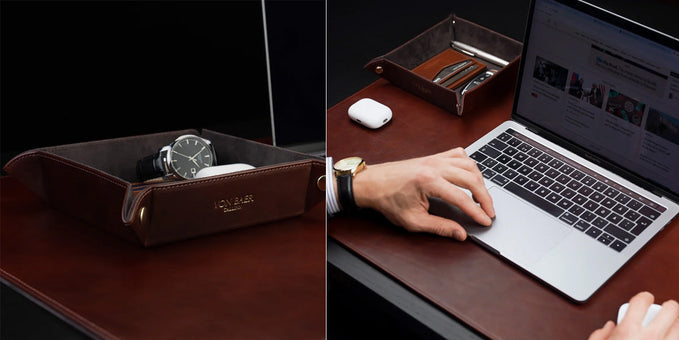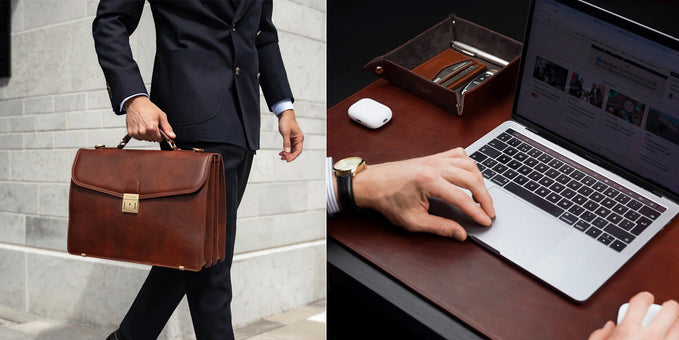How to Waterproof Your Leather Bag?

Can You Make Leather Waterproof?
You can't make leather fully waterproof, but you can make it highly water-resistant.
Applying treatments like waterproofing sprays or wax creates a protective barrier that prevents moisture from penetrating deeply.
Regular maintenance helps guard leather against light rain and spills without affecting its natural look and feel.
DIY Leather Waterproofing
Waterproofing leather at home can be surprisingly effective when you choose quality products and apply them with care.
Here’s how to create a lasting, water-resistant barrier on your bag in a few simple yet expert-level steps:
1. Start with a Spotless Surface

- Before any waterproofing, a thorough cleaning is essential.
- Even a thin layer of dust or oil can prevent products from bonding with the material.
- Wipe your bag down with a microfiber or soft cloth, and for stubborn spots, use a leather cleaner specifically formulated to avoid over-saturating or discoloring the leather.
- Avoid household cleaners, as they can be too harsh and disrupt the leather’s natural pH balance.
2. Condition the Leather
- Apply a high-quality conditioner (ideally one with natural oils or waxes) to nourish the material, restoring oils and flexibility.
- Leather that’s soft and supple accepts waterproofing more evenly and is less prone to cracking.
- Massage the conditioner in with circular motions, focusing on high-wear areas like handles and corners, which dry out more quickly.
We recommend this Premium Leather Cream - here's how to apply it:
3. Choose the Right Waterproofing Product for Your Leather Type
- Leather Protectant Sprays: A convenient choice for smooth leather, these sprays create an invisible, water-repellent barrier. They’re easy to apply and won’t alter the color of your leather. Look for alcohol-free formulas as they’re less likely to dry out the surface.
- Beeswax-Based Creams: For a heavier-duty barrier, waxes work well on full-grain or vegetable-tanned leather. Apply sparingly at first to avoid darkening the color. Test on a small area to confirm the effect, then work the cream in with a soft cloth for thorough coverage.
- Natural Oils: Oils such as mink or neatsfoot oil offer a gentle, effective waterproofing option. However, they tend to darken leather more than creams or sprays. Use these sparingly and only on darker colors or test in an inconspicuous area.
4. Apply the Waterproof Layer

- When using a spray, hold it at a distance of about 6-8 inches to ensure an even coat.
- For creams or oils, apply a thin layer, working it in until you achieve a slight sheen.
- Ensure that seams, edges, and handles—often missed areas—are adequately covered.
5. Drying and Setting
Allow your bag to dry naturally. Avoid direct sunlight or artificial heat, as these can cause the leather to become stiff or fade. Give each layer ample time to absorb, setting the waterproofing layer effectively.
Tip: Reapply waterproofing every 6-8 weeks if you frequently use your bag outdoors, or less often if it primarily stays indoors. This helps maintain protection against unexpected moisture.
Can You Make Your Own Waterproofer?
Yes, you can make your own waterproofer using beeswax:
- Simply add 2 parts beeswax and 1 part olive oil into a glass container, and heat it in a pan of water while stirring.
- Leave to cool while stirring to ensure the wax has melted.
- Before applying anything to your leather bag, spot-test it in a discrete area first to ensure you're happy with the appearance and feel before you apply it to your entire bag.
Learn more about if leather is waterproof already here.
Are Leather Bags Naturally Waterproof?

Leather is celebrated for its durability, sophistication, and timeless style, though it is not naturally waterproof.
This material is porous—it’s a skin, after all.
Even high-quality leather that has undergone specialized finishing treatments retains some level of porosity, which allows it to absorb moisture if unprotected.
Without a waterproof layer, leather bags are susceptible to getting wet, leading to staining, darkening, and, over time, structural degradation.
Impact of Water Exposure
When exposed to water, untreated leather absorbs it, especially around seams, edges, and any areas with natural creasing.
Over time, the fibers may stiffen and crack, leading to a brittle surface that can split or peel. This is especially risky if you carry your bag through city rainstorms or snowy commutes.
With a carefully chosen waterproofing product, you can create a barrier that helps preserve both the visual appeal and structural integrity of your favorite bag.
Why Some Leather Types Are Slightly Water-Resistant

Certain types of leather, such as patent or finished leather, may initially repel water due to specific treatments that seal the surface.
These are typically glossy or have a protective layer added during the tanning process.
However, this is not full waterproofing.
Exposure to rain or damp conditions without added protection will eventually penetrate even these types.
Only a consistent, intentional waterproofing regimen provides reliable protection for genuine leather products.
This applies to all types of leather, even full-grain leather.
If it does get excessively wet, see our guide on how to remove a water stain.
What to Expect with Waterproofed Leather
Even after waterproofing, your leather will retain a soft feel and luxurious finish.
Rather than sitting as a heavy layer, the waterproofing treatment binds to the surface, creating a thin, flexible film.
For instance, a high-quality beeswax treatment or silicone-based spray becomes part of the material without making it feel synthetic or rigid.
Can Leather Bags Get Wet? The Real Impact of Moisture on Leather

Yes, leather bags can get wet, and the effects of moisture on untreated material can be drastic. Leather’s natural fibers are like small, interconnected channels.
When water is absorbed, these channels expand, causing the fibers to swell and lose their softness. Once it dries, the water evaporates, leaving the material stiff and sometimes warped.
Consider what happens if a bag gets drenched in the rain: the water may initially only affect the surface, but as it seeps in, it can leave darker stains on lighter colors or cause subtle changes in darker tones.
The longer the exposure, the deeper the water goes, reaching the interior structure, where moisture weakens the cellular composition, leading to cracking or splitting.
Damage at this level often requires professional repair and, in many cases, may be irreversible, especially if cracks form along seams or on prominent areas.
Practical Tip: After waterproofing, keep a small, absorbent cloth in your bag. If caught in a downpour, lightly blot any water off immediately. This limits how much moisture reaches deeper layers, giving your waterproofing layer time to perform.
Protecting Your Leather Bag from Rain: Advanced Maintenance Tips

Maintaining your bag’s water resistance goes beyond applying a waterproofing product. Here’s how to make your bag truly city-proof, even through seasons of rain and snow:
-
Regular Conditioning: Moisturize the leather every 2-3 months to maintain its flexibility and resist cracking. Leather that’s hydrated retains waterproof treatments better and develops a richer patina over time. Look for conditioners that contain lanolin or jojoba oil, as they’re close to the material’s natural oils.
-
Optimal Storage: Avoid storing bags in places with high humidity. A cloth dust bag helps shield from dust and prevents moisture buildup that can lead to mold. If your home is particularly humid, consider placing a small silica gel packet near your bag to help absorb any excess moisture.
-
Handling Excess Moisture: If your waterproofed bag does get damp, blot it with a soft, absorbent cloth immediately. Avoid rubbing, which can disrupt the grain or cause discoloration. Allow it to dry naturally in an open space, never near heat sources that can cause rapid drying and lead to brittleness.
By conditioning and properly storing your bag, you create a holistic care routine that extends its waterproofing effects and keeps it looking pristine.

Author: Albert Varkki
Albert Varkki is the co-founder of Von Baer. He understands leather products as a consumer, supplier, and a manufacturer, helping you with the inside knowledge you need, to choose the perfect leather product for you.
We strive for the highest editorial standards, and to only publish accurate information on our website.
Leave a Comment
Your email address will not be published.






